Effect of Overburden Depth and Stress Anisotropy on a Ground Reaction Caused by Advancing Excavation of a Circular Tunnel
Abstract
1. Introduction
2. Coordinate Transformation and Description of Near and Far Stress Fields
2.1. Coordinate Transformation for Describing the Effect of Overburden Depth
2.2. Changes in Stress Gradient around the Tunnel
- (1)
- Initial in situ stresses in the far field (r → ∞): Before the tunnel is excavated, the stratum stress is in a state of static overburden stress. Therefore, the initial anisotropic stress in the formation can be shown in Figure 3, and its stress equation can be expressed aswhere and are the initial tangential stress and the initial radial stress, respectively.
- (2)
- Final stresses or the boundary stresses at the intrados of the tunnel in the near field (R ≤ r < ∞): After the tunnel excavation is completed, the stress around the tunnel will change. This final stress can be obtained by Kirsch’s solution, and its stress equation can be expressed aswhere and are the final tangential stress and the final radial tress around the tunnel proximity, respectively.
3. Derivation of Stress/Displacement in the Elastic and Plastic Regions
3.1. Plastic Radius and Stresses in the Plastic Region
3.2. Derivation of Displacements in the Elastic and Plastic Regions
- (1)
- In the plastic region (R ≦ r ≦ Rp), the radial displacement is obtained as
- (2)
- The radial displacement at the elastic-plastic interface (r = Rp):
- (3)
- In the elastic region (Rp ≦ r), the radial displacement becomes
4. Numerical Analysis Process and Calculation Steps
4.1. Incremental Procedure for Explicit Analysis Method
- (1)
- Input the following data: physical properties and mechanical parameters of materials, geometric parameters of the analysis range, unsupported distance, and initial in situ stress.
- (2)
- Select a value of confinement loss λz at a certain distance z from the tunnel face to simulate the effect of advancing excavation due to the unsupported distance of the tunnel.
- (3)
- Subdivide the confinement loss λz into n segments, so the incremental step Δλ can be expressed as
- (4)
- Calculate the value of each incremental step λ as
- (5)
- Superimpose each incremental step and reach the final value
- (6)
- Use Equation (27) to calculate the confinement loss at the elastic limit λz.
- (7)
- If , it indicates that the stress state is in the elastic region. At this point, the radial and tangential stress/displacement can be calculated using Equations (18), (19) and (33), respectively.
- (8)
- Else, if , it indicates that that the stress state is in the plastic region. Thus, the plastic radius Rp can be calculated using Equation (26). Thereafter, the developed program automatically calculates the radial and tangential stresses and the radial displacements according to Equations (22), (23) and (40), respectively.
- (9)
- The program records the calculated data and presents them in the following stress/displacement distribution format: (, r/R), (, r/R), and (, r/R).
- (10)
- When i < n − 1, iterate step (4) through step (10).
- (11)
- When i = n − 1, the process is stopped. Record the data from each step.
- (12)
- The program will systematically draw the stress/displacement distribution of the tunnel section as shown in Figure 5.
4.2. Numerical Analysis of Finite Element Method
- (1)
- Pre-processing program: prepare calculation data, including calculation range, automatically generated 2D excavation and support meshes, calculation matrix optimization, re-node numbering, input parameters according to the selected composition mode, and define each module group, boundary conditions and the use of the initial stress method, the number of iterative operations, and the allowable accuracy.
- (2)
- Main calculation program: read data and related calculations, including the parameters of each group of elements, the total domain coordinate value of each node, the parameters of the constitutive law of each module, the degree of freedom of each node, the state of force, the number of repeated operations, and the allowable accuracy value, etc.
- (3)
- Post-processing programs: visual interface processing and drawing output, including the iso-value of the displacement distribution map, and total displacement, the iso-value of the stress distribution map of principal stress and deviatoric stress, the distribution map of stress field and displacement field, etc.
5. Comparison of Results Obtained by EAM and FEM
- (1)
- (2)
- When the stresses are in the elastic region (0 < λ < λe, Rp < r < ∞), as the value of the confinement loss increases, the radial stress gradually decreases (Figure 11a), while the tangential stress (Figure 11b) and the radial displacement (Figure 11c) increase gradually. In addition, it can be observed that both stresses are distributed along the horizontal axis r/R and separated in a symmetrical shape (Figure 11d);
- (3)
- (4)
- When the stresses are in the plastic region (λe < λ < 1, R < r < Rp), as the value of the confinement loss continues to increase, both the radial stress and the tangential stress decrease sharply (Figure 12d);
- (5)
- When it is located at the intrados of the tunnel (λ = 1.0, r = R) as the tangential stress is just equal to the uniaxial compressive strength (UCS) of the ground, the radial stress is completely released to zero (Figure 12d).
6. Discussion
7. Conclusions
- (1)
- The theoretical analysis and numerical calculation of the ground reaction caused by the advancing excavation of a circular tunnel under anisotropic stress conditions influenced by the overburden depth is investigated in this paper.
- (2)
- It can be determined that the distribution of stress/displacement induced by tunnel advancing excavation is not affected by the overburden depth along the tunnel spring line in Case II, whether under isotropic or anisotropic stress conditions. In addition, it is not the case in Cases I and III, which are affected by the overburden depth.
- (3)
- The influence of these two factors, overburden depth and stress anisotropy, can be described by using the distribution map of the tunnel radial stress.
- (4)
- The comparison results of the EAM analysis proposed in this study with the FEM numerical analysis can not only present the distribution curve of the overburden pressure but also describe the variation of the surrounding area caused by the tunnel advancing excavation.
- (5)
- Due to the influence of overburden depth, the tangential stress, radial displacement, and plastic zone range of the tunnel invert are much larger than those of the tunnel crown, which cannot be considered and simulated by traditional CCM theoretical analysis.
- (6)
- Three assumptions of different boundary conditions that the initial anisotropic stress varies with the influence of the overburden depth are put forward to improve the defects that cannot be considered in the analysis of the traditional CCM.
- (7)
- The analytical closed-form solution interpreted by the incremental procedure was derived for considering the effect of advancing excavation of a circular tunnel in an elastoplastic media.
- (8)
- To use the confinement loss as an incremental step, simulation of the effect of advancing excavation of a circular tunnel is proposed and achieved by using the incremental procedure of the EAM to realize the calculation.
- (9)
- The results obtained by the closed-form solution explained by the incremental procedure show a very consistent trend with the results of the finite element analysis.
- (10)
- The EAM proposed in this study can deal with the influence of overburden depth and stress anisotropy, not only as a useful tool for deep tunnel support design, but also as a method which may be applied to shallow tunnel behavior in the next stage of research.
Author Contributions
Funding
Conflicts of Interest
References
- Panet, M. Le Calcul des Tunnels par la Méthode Convergence-Confinement; Presses de l’Ecole Nationale des Ponts et Chaussées: Paris, France, 1995. [Google Scholar]
- Panet, M.; Sulem, J. Convergence-Confinement Method for Tunnel Design; Springer: Cham, Switzerland, 2022. [Google Scholar]
- Lee, Y.-L.; Hsu, W.-K.; Lee, C.-M.; Xin, Y.-X.; Zhou, B.-Y. Direct Calculation Method for the Analysis of Non-linear Behavior of Ground-Support Interaction of a Circular Tunnel Using Convergence Confinement Approach. Geotech. Geol. Eng. 2021, 39, 973–990. [Google Scholar] [CrossRef]
- Lee, Y.-L.; Hsu, W.-K.; Chou, P.-Y.; Hsieh, P.-W.; Ma, C.-H.; Kao, W.-C. Verification and Comparison of Direct Calculation Method for the Analysis of Support–Ground Interaction of a Circular Tunnel Excavation. Appl. Sci. 2022, 12, 1929. [Google Scholar] [CrossRef]
- Oreste, P. The convergence–confinement method: Roles and limits in modern geomechanical tunnel design. Am. J. Appl. Sci. 2009, 6, 757–771. [Google Scholar] [CrossRef]
- Pacher, F. Deformationsmessungen im Versuchsstollen als Mittel zur Erforschung des Gebirgsverhaltens und zur Bemessung des Ausbaues. In Grundfragen auf dem Gebiete der Geomechanik; Felsmechanik und Ingenieurgeologie; Springer: Berlin/Heidelberg, Germany, 1964; pp. 149–161. [Google Scholar] [CrossRef]
- Panet, M. Recommendations on the Convergence-Confinement Method, Association Française des Tunnels et de l’Espace Souterrain (AFTES). 2001. pp. 1–11. Available online: https://tunnel.ita-aites.org/media/k2/attachments/public/Convergence-confinement%20AFTES.pdf. (accessed on 28 September 2022).
- Brown, E.T.; Bray, J.W.; Ladanyi, B.; Hoek, E. Ground Response Curves for Rock Tunnels. J. Geotech. Eng. 1983, 109, 15–39. [Google Scholar] [CrossRef]
- Brady, B.; Brown, E. Rock Mechanics for Underground Mining; Chapman & Hall: London, UK, 1993. [Google Scholar]
- Wang, Y. Ground Response of Circular Tunnel in Poorly Consolidated Rock. J. Geotech. Eng. 1996, 122, 703–708. [Google Scholar] [CrossRef]
- Carranza-Torres, C.; Fairhurst, C. The elasto-plastic response of underground excavations in rock masses that satisfy the Hoek–Brown failure criterion. Int. J. Rock Mech. Min. Sci. 1999, 36, 777–809. [Google Scholar] [CrossRef]
- Carranza-Torres, C.; Fairhurst, C. Application of the Convergence-Confinement method of tunnel design to rock masses that satisfy the Hoek-Brown failure criterion. Tunn. Undergr. Space Technol. 2000, 15, 187–213. [Google Scholar] [CrossRef]
- Oreste, P.P. Analysis of structural interaction in tunnels using the covergence-confinement approach. Tunn. Undergr. Space Technol. 2003, 18, 347–363. [Google Scholar] [CrossRef]
- Sharan, S. Exact and approximate solutions for displacements around circular openings in elastic–brittle–plastic Hoek–Brown rock. Int. J. Rock Mech. Min. Sci. 2005, 42, 542–549. [Google Scholar] [CrossRef]
- Carranza-Torres, C. Elasto-plastic solution of tunnel problems using the generalized form of the hoek-brown failure criterion. Int. J. Rock Mech. Min. Sci. 2004, 41, 629–639. [Google Scholar] [CrossRef]
- Cui, L.; Zheng, J.-J.; Zhang, R.-J.; Lai, H.-J. A numerical procedure for the fictitious support pressure in the application of the convergence–confinement method for circular tunnel design. Int. J. Rock Mech. Min. Sci. 2015, 78, 336–349. [Google Scholar] [CrossRef]
- Park, K.-H.; Kim, Y.-J. Analytical solution for a circular opening in an elastic–brittle–plastic rock. Int. J. Rock Mech. Min. Sci. 2006, 43, 616–622. [Google Scholar] [CrossRef]
- Guan, Z.; Jiang, Y.; Tanabasi, Y. Ground reaction analyses in conventional tunnelling excavation. Tunn. Undergr. Space Technol. 2007, 22, 230–237. [Google Scholar] [CrossRef]
- Serrano, A.; Olalla, C.; Reig, I. Convergence of circular tunnels in elastoplastic rock masses with non-linear failure criteria and non-associated flow laws. Int. J. Rock Mech. Min. Sci. 2011, 48, 878–887. [Google Scholar] [CrossRef]
- Alejano, L.; Rodriguez-Dono, A.; Alonso, E.; Fdez-Manín, G. Ground reaction curves for tunnels excavated in different quality rock masses showing several types of post-failure behaviour. Tunn. Undergr. Space Technol. 2009, 24, 689–705. [Google Scholar] [CrossRef]
- Oreste, P.; Pella, D. Modelling progressive hardening of shotcrete in convergence-confinement approach to tunnel design. Tunn. Undergr. Space Technol. 1997, 12, 425–431. [Google Scholar] [CrossRef]
- Rodríguez, R.; Díaz-Aguado, M.B. Deduction and use of an analytical expression for the characteristic curve of a support based on yielding steel ribs. Tunn. Undergr. Space Technol. 2013, 33, 159–170. [Google Scholar] [CrossRef]
- Oke, J.; Vlachopoulos, N.; Diederichs, M. Improvement to the Convergence-Confinement Method: Inclusion of Support Installation Proximity and Stiffness. Rock Mech. Rock Eng. 2018, 51, 1495–1519. [Google Scholar] [CrossRef]
- Gschwandtner, G.G.; Galler, R. Input to the application of the convergence confinement method with time-dependent material behaviour of the support. Tunn. Undergr. Space Technol. 2012, 27, 13–22. [Google Scholar] [CrossRef]
- Sandrone, F.; Labiouse, V. Analysis of the evolution of road tunnels equilibrium conditions with a convergence–confinement approach. Rock Mech. Rock Eng. 2010, 43, 201–218. [Google Scholar] [CrossRef]
- Bernaud, D.; Rousset, G. The ‘new implicit method’ for tunnel analysis. Int. J. Numer. Anal. Methods Géoméch. 1996, 20, 673–690. [Google Scholar] [CrossRef]
- De La Fuente, M.; Taherzadeh, R.; Sulem, J.; Nguyen, X.-S.; Subrin, D. Applicability of the convergence-confinement method to full-face excavation of circular tunnels with stiff support system. Rock Mech. Rock Eng. 2019, 52, 2361–2376. [Google Scholar] [CrossRef]
- Panet, M.; Guenot, A. Analysis of convergence behind the face of a tunnel. In Proceedings of the 3rd International Symposium, Brighton, UK, 7–11 June 1982; pp. 197–204. [Google Scholar]
- Humbert, P.; Dubouchet, A.; Fezans, G.; Remaud, D. CESAR-LCPC, un progiciel de calcul dédié au génie civil. Bull. Lab. Ponts Chaussées 2005, 256, 7–37. Available online: https://www.ifsttar.fr/collections/BLPCpdfs/blpc_256-257_7-37.pdf. (accessed on 28 September 2022).
- Mousivand, M.; Maleki, M. Constitutive Models and Determining Methods Effects on Application of Convergence–Confinement Method in Underground Excavation. Geotech. Geol. Eng. 2017, 36, 1707–1722. [Google Scholar] [CrossRef]
- Mousivand, M.; Maleki, M.; Nekooei, M.; Mansoori, M.R. Application of Convergence–Confinement Method in Analysis of Shallow Non-circular Tunnels. Geotech. Geol. Eng. 2017, 35, 1185–1198. [Google Scholar] [CrossRef]
- Panet, M. Calcul du souténement des tunnels à section circulaire par la méthode convergence-confinement avec un champ de contraintes initiales anisotropes. Tunn. Ouvrages Souterr. 1986, 77, 228–232. [Google Scholar]
- Detournay, E.; St. John, C.M. Design charts for a deep circular tunnel under non-uniform loading. Rock Mech. Rock Eng. 1988, 21, 119–137. [Google Scholar] [CrossRef]
- Ravandi, E.G.; Rahmannejad, R. Wall displacement prediction of circular, D shaped and modified horseshoe tunnels in non-hydrostatic stress fields. Tunn. Undergr. Space Technol. 2013, 34, 54–60. [Google Scholar] [CrossRef]
- Shen, B.; Barton, N. The disturbed zone around tunnels in jointed rock Masses. Int. J. Rock Mech. Min. Sci. 1997, 34, 117–125. [Google Scholar] [CrossRef]
- Panthi, K.K.; Shrestha, P.K. Estimating Tunnel Strain in the Weak and Schistose Rock Mass Influenced by Stress Anisotropy: An Evaluation Based on Three Tunnel Cases from Nepal. Rock Mech. Rock Eng. 2018, 51, 1823–1838. [Google Scholar] [CrossRef]
- Lee, Y.-L. Explicit Procedure and Analytical Solution for the Ground Reaction Due to Advance Excavation of a Circular Tunnel in an Anisotropic Stress Field. Geotech. Geol. Eng. 2018, 36, 3281–3309. [Google Scholar] [CrossRef]
- Vitali, O.P.M.; Celestino, T.B.; Bobet, A. Analytical Solution for a Deep Circular Tunnel in Anisotropic Ground and Anisotropic Geostatic Stresses. Rock Mech. Rock Eng. 2020, 53, 3859–3884. [Google Scholar] [CrossRef]
- Lee, Y.-L. Explicit analysis for the ground-support interaction of a circular tunnel excavation in anisotropic stress fields. J. Chin. Inst. Eng. 2020, 43, 13–26. [Google Scholar] [CrossRef]
- Zhao, K.; Bonini, M.; Debernardi, D.; Janutolo, M.; Barla, G.; Chen, G. Computational modelling of the mechanised excavation of deep tunnels in weak rock. Comput. Geotech. 2015, 66, 158–171. [Google Scholar] [CrossRef]
- Lee, Y.-L. Incremental procedure method for the analysis of ground reaction due to excavation of a circular tunnel by considering the effect of overburden depth. Tunn. Undergr. Space Technol. 2019, 93, 103059. [Google Scholar] [CrossRef]
- González-Nicieza, C.; Álvarez-Vigil, A.; Menéndez-Díaz, A.; González-Palacio, C. Influence of the depth and shape of a tunnel in the application of the convergence–confinement method. Tunn. Undergr. Space Technol. 2008, 23, 25–37. [Google Scholar] [CrossRef]
- Vlachopoulos, N.; Diederichs, M.S. Improved Longitudinal Displacement Profiles for Convergence Confinement Analysis of Deep Tunnels. Rock Mech. Rock Eng. 2009, 42, 131–146. [Google Scholar] [CrossRef]
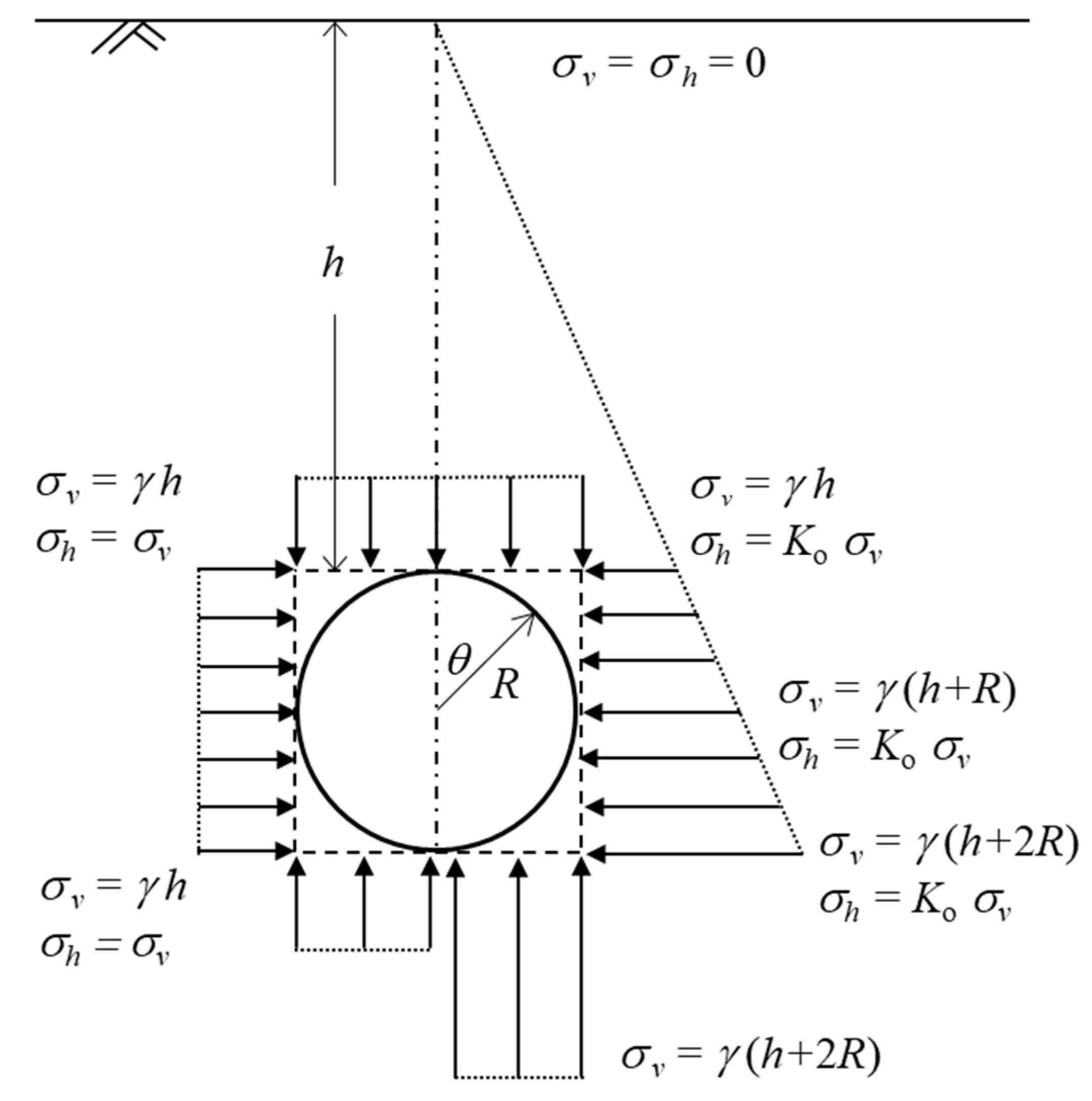
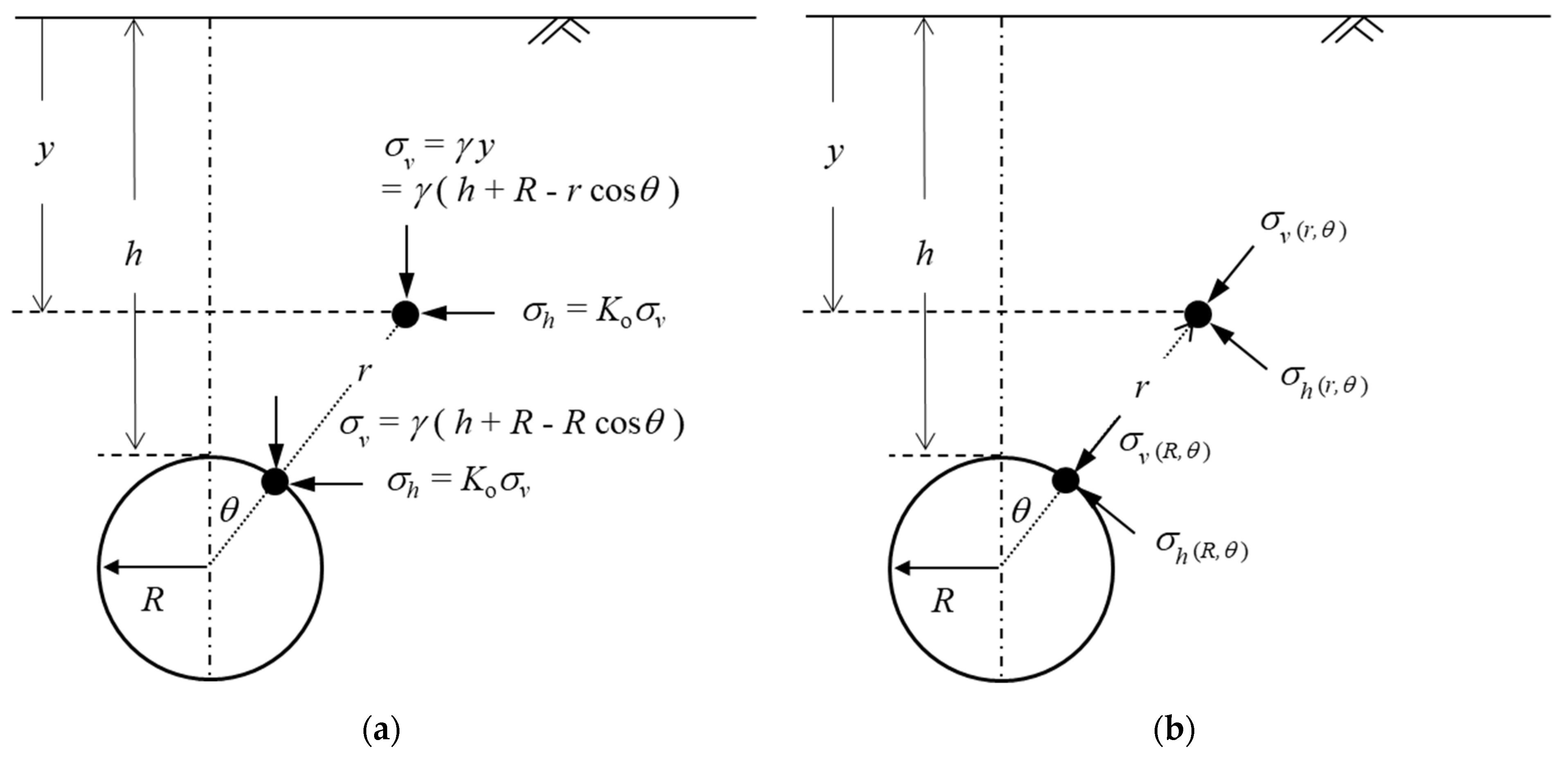
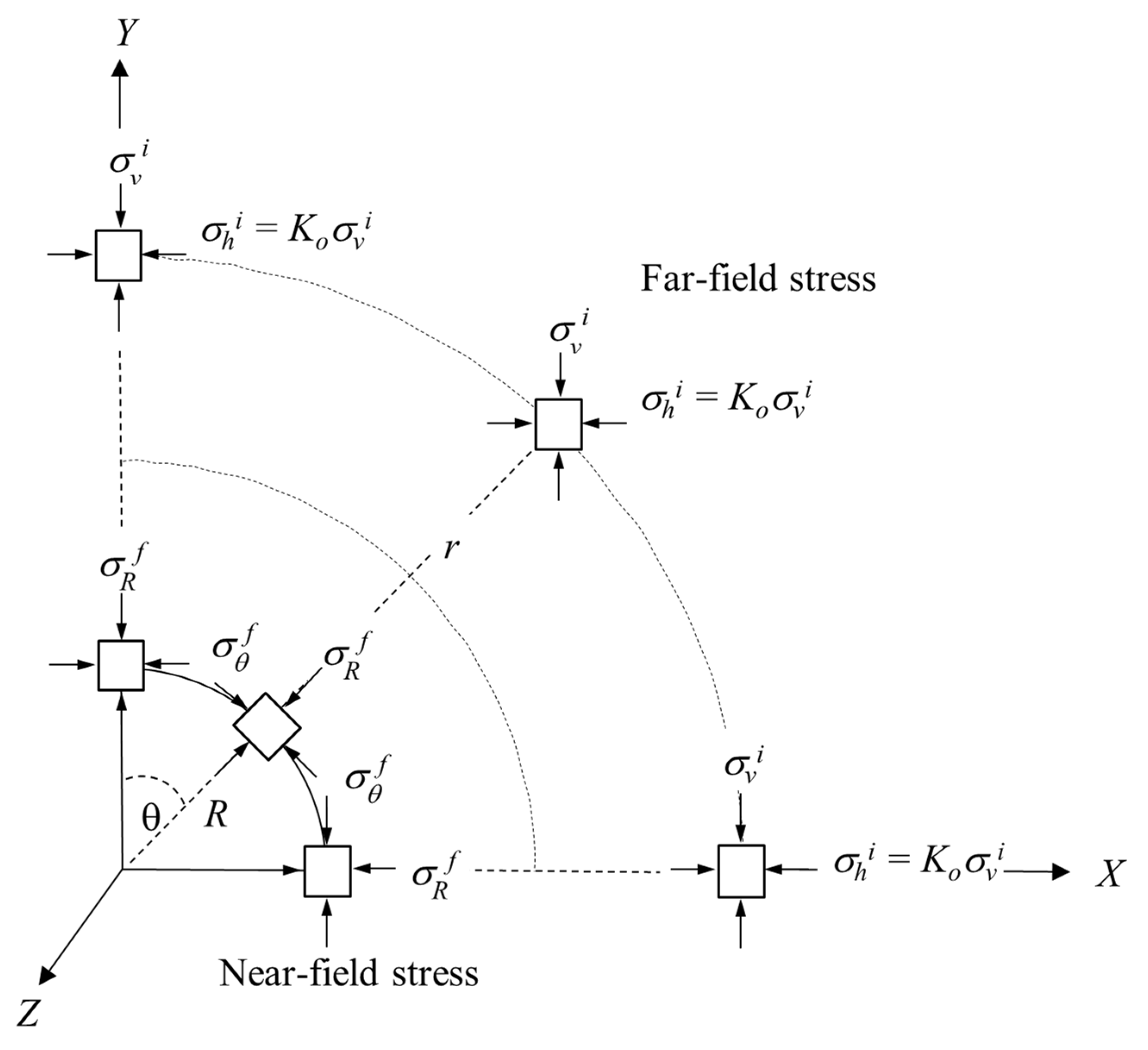

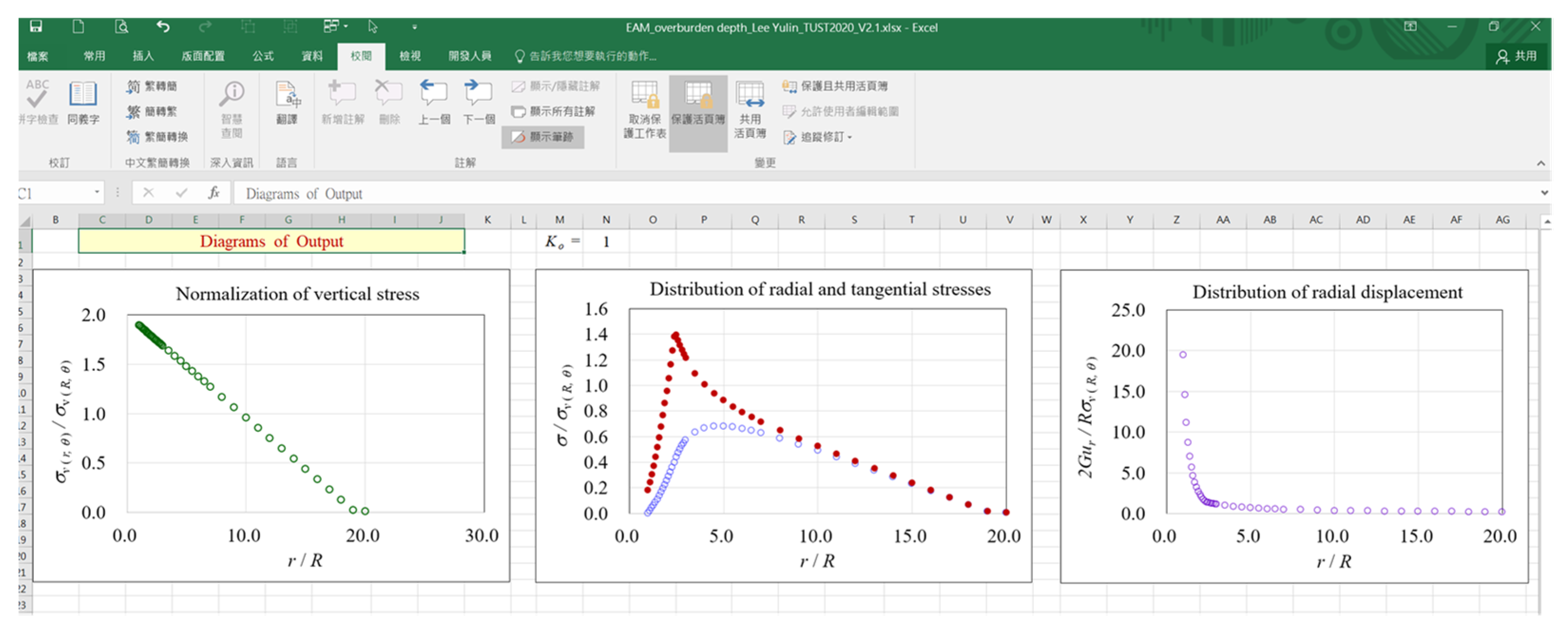
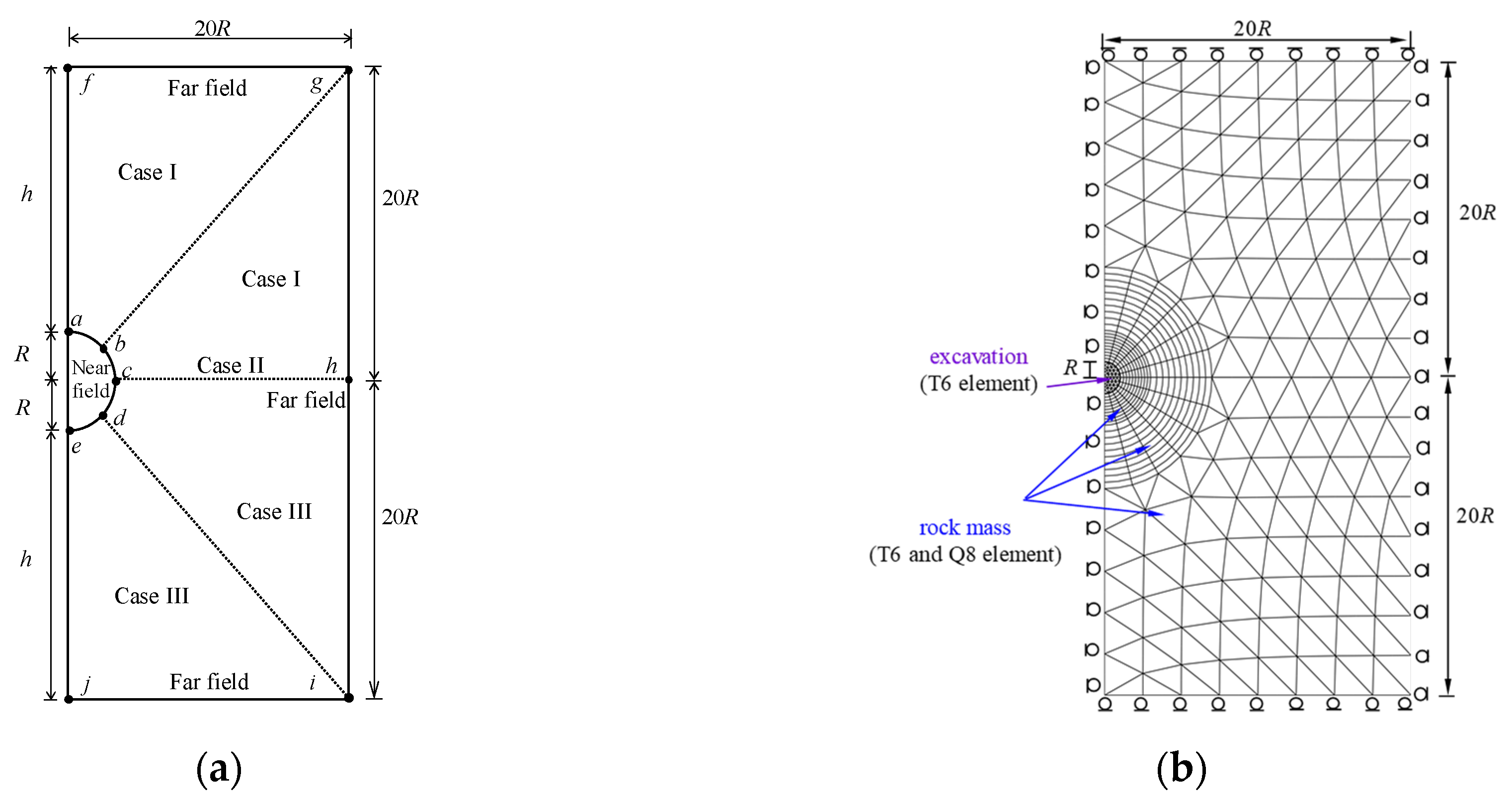
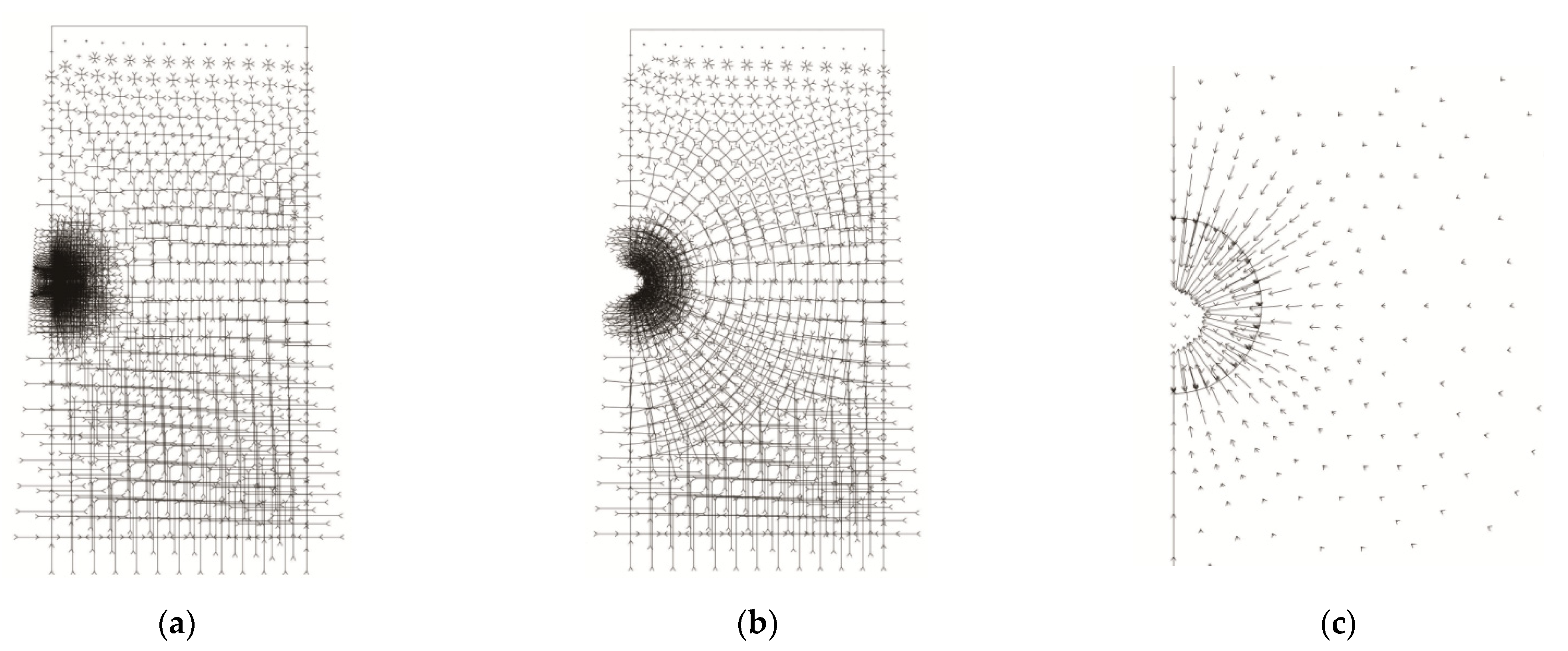
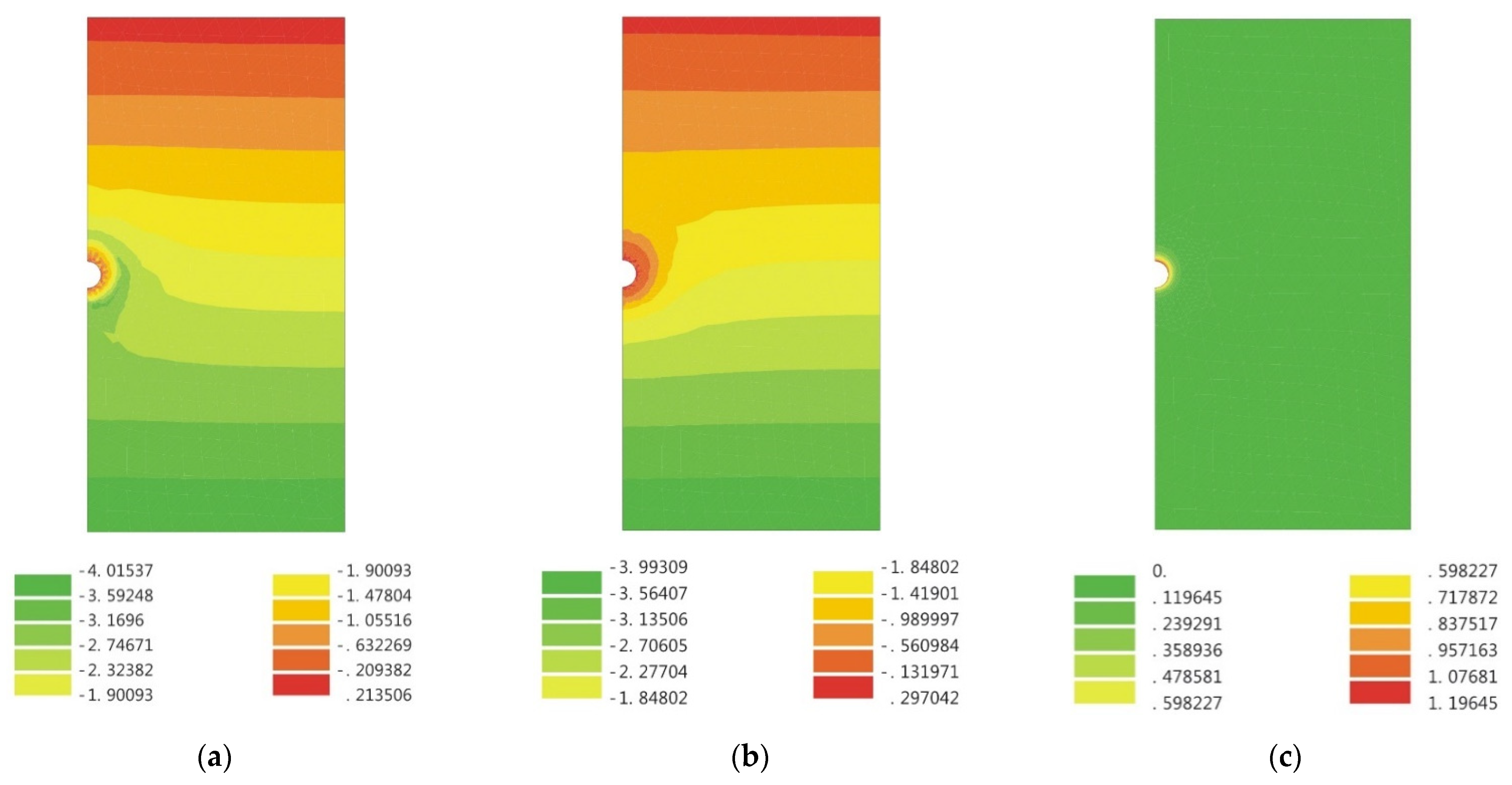
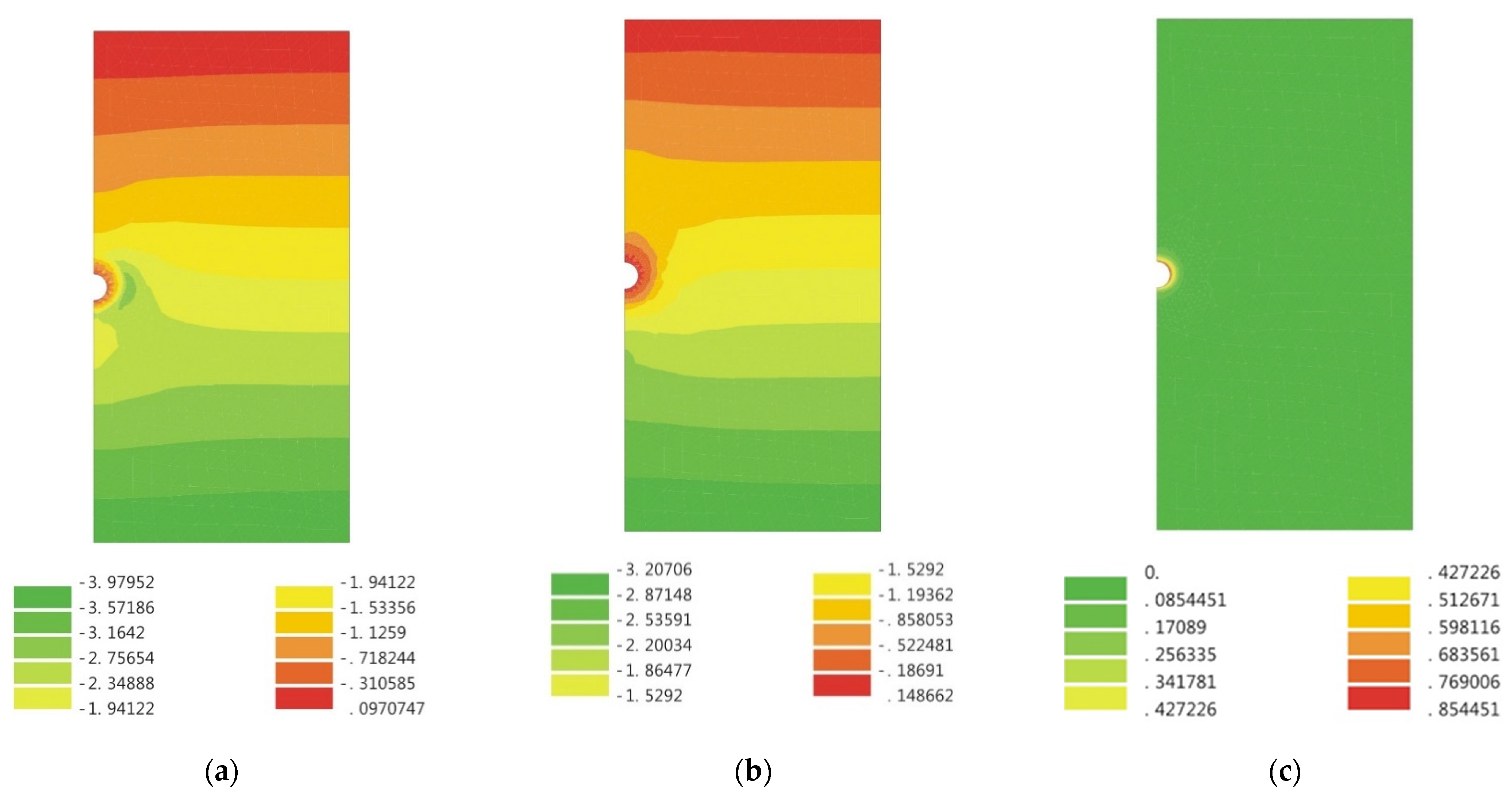
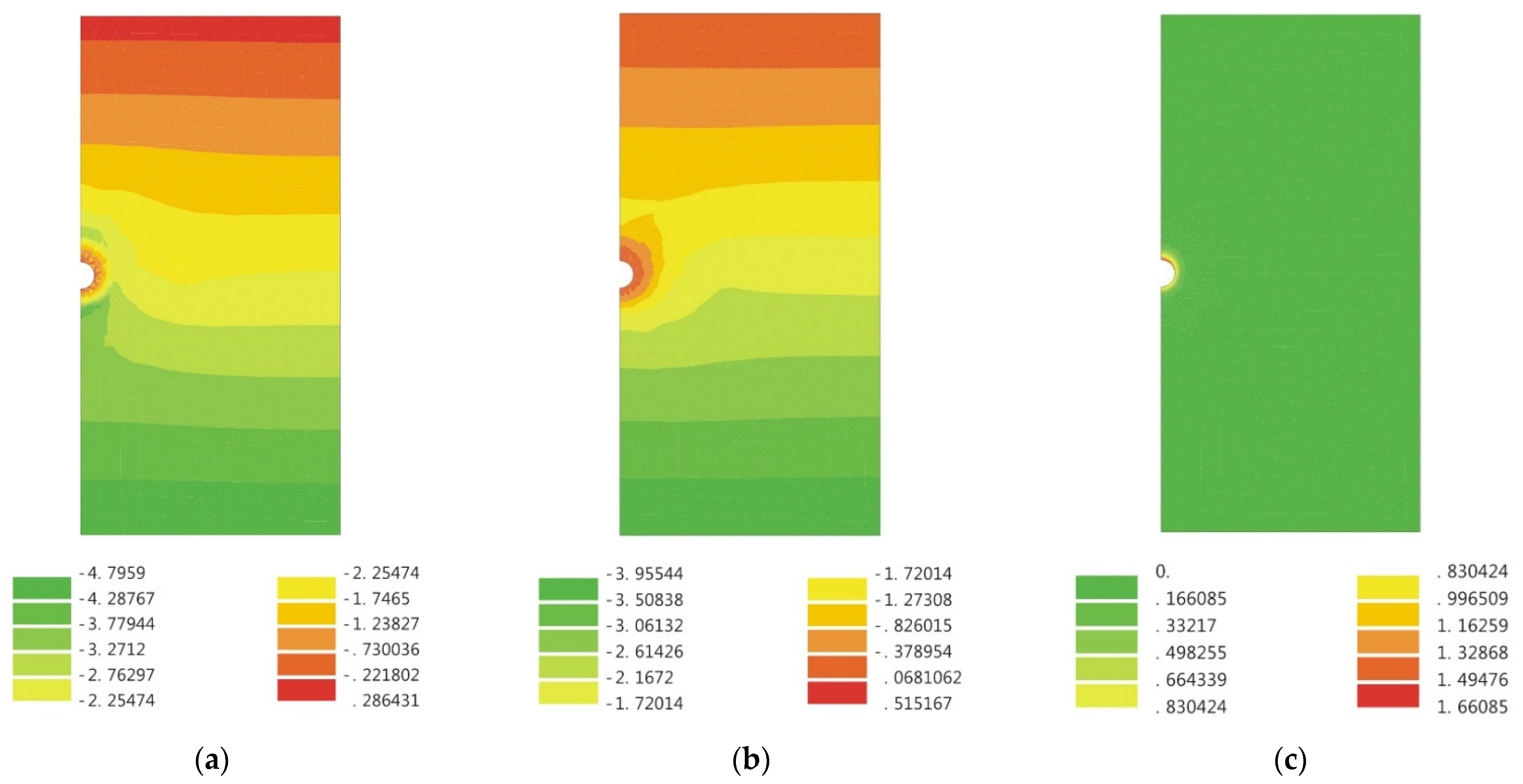


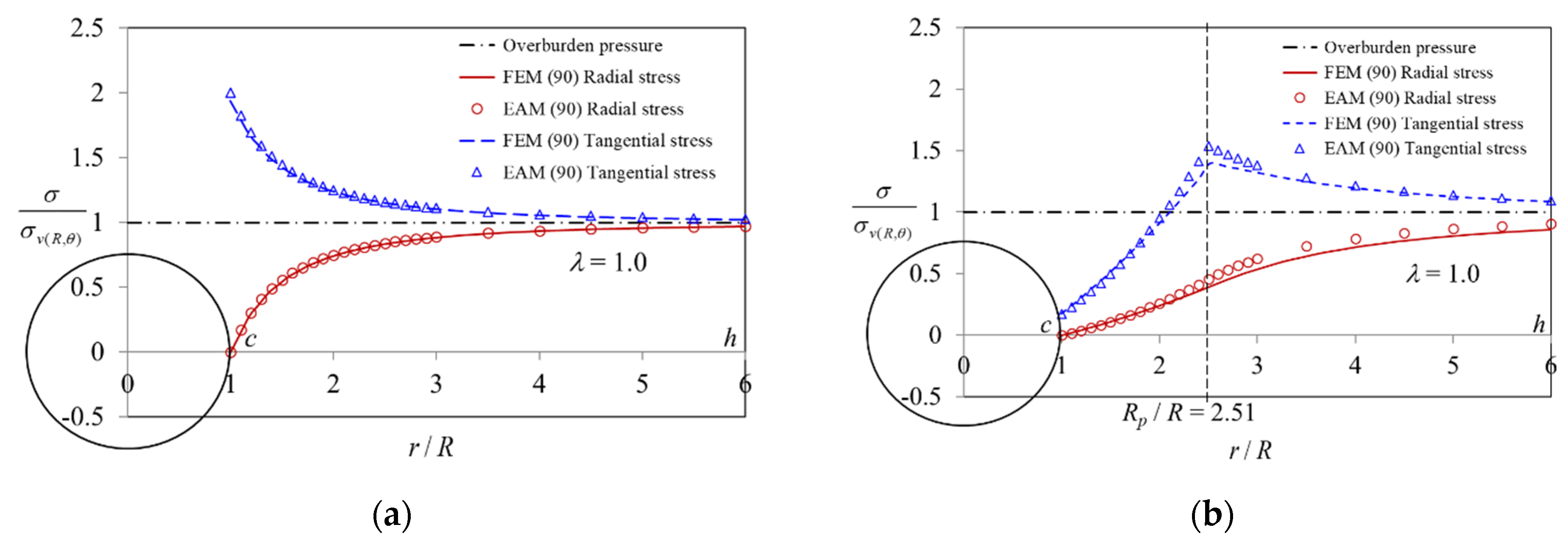

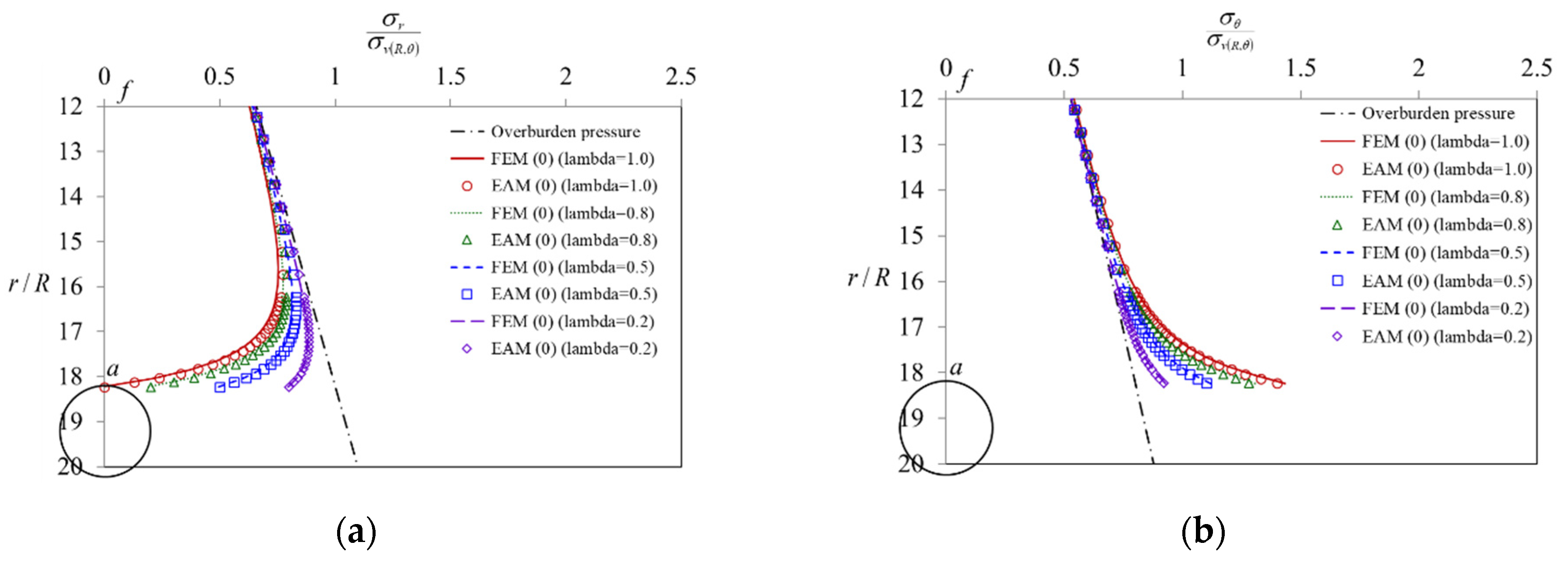
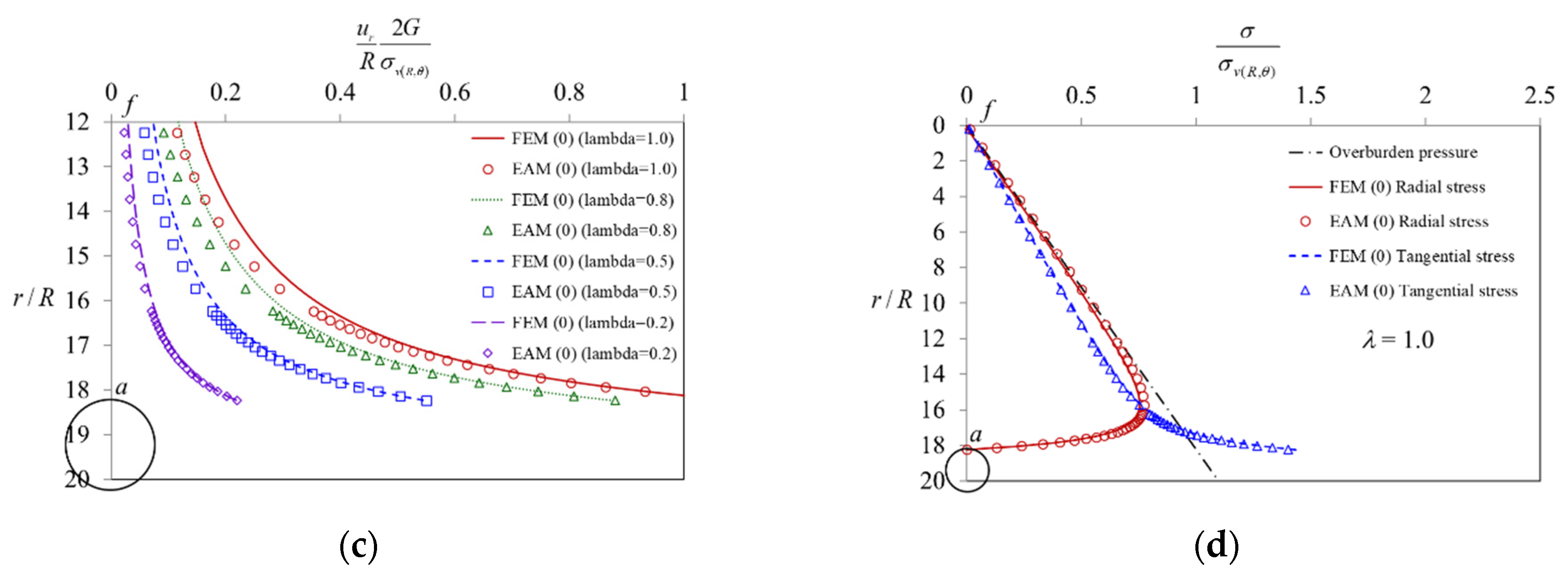

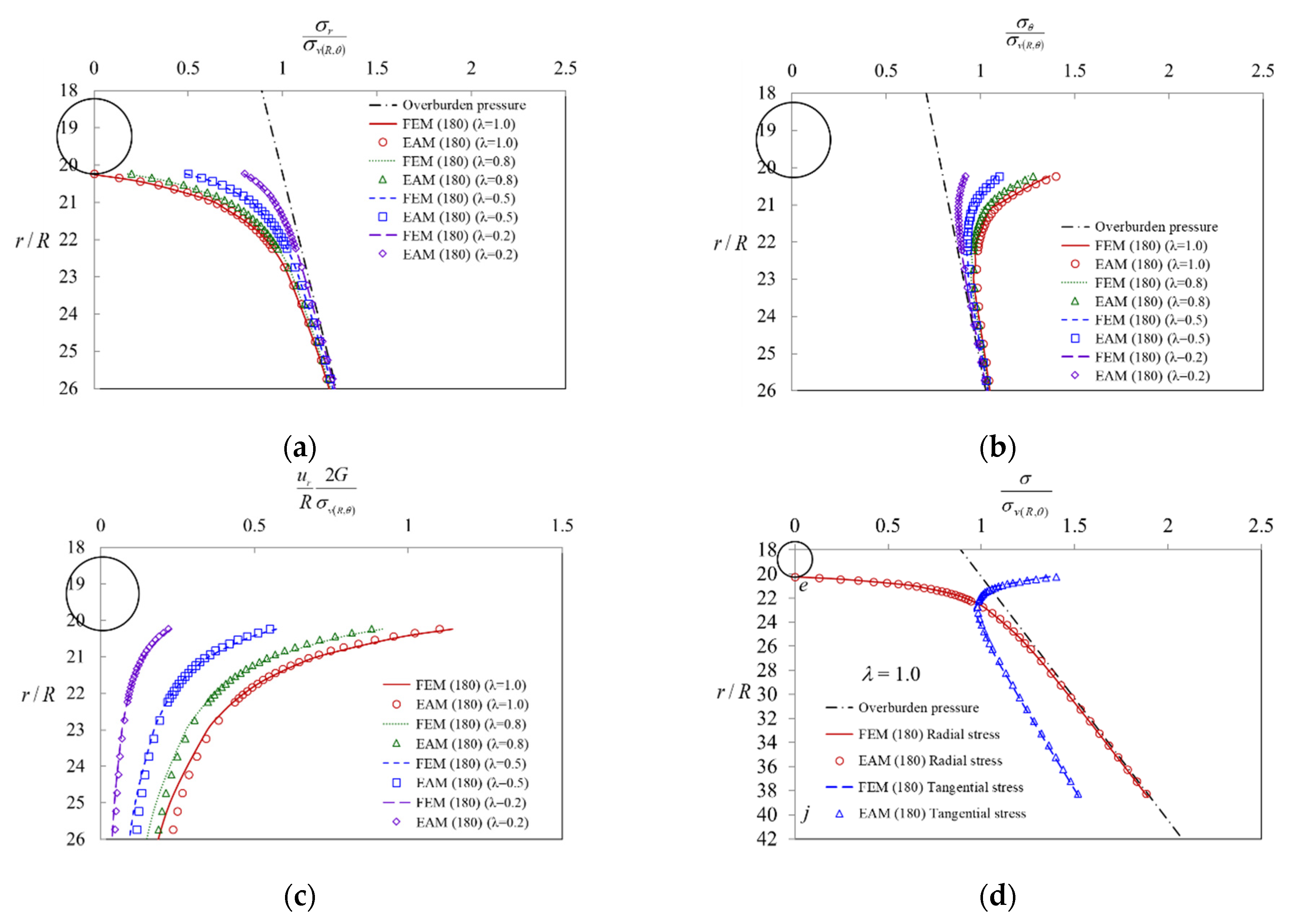
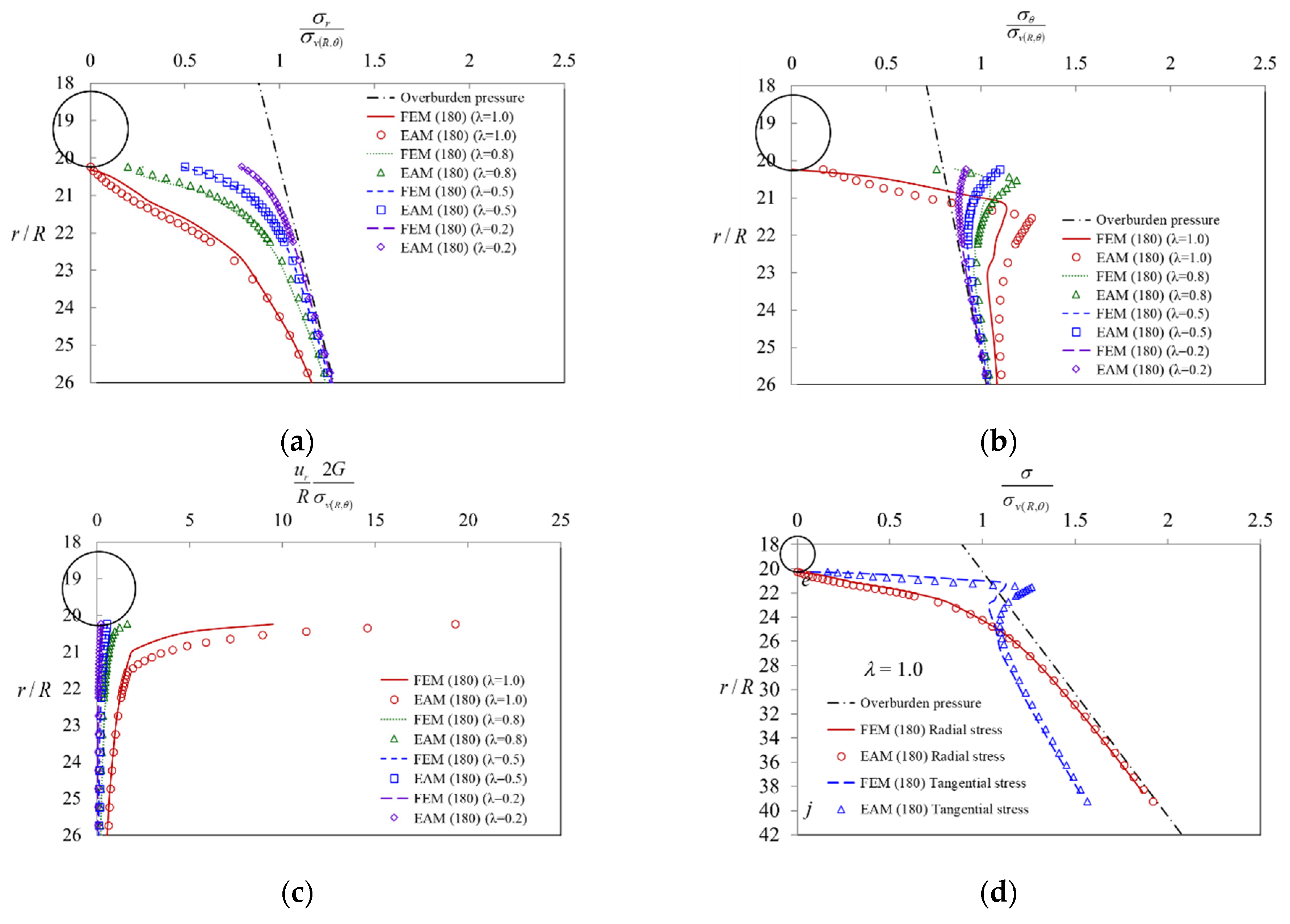
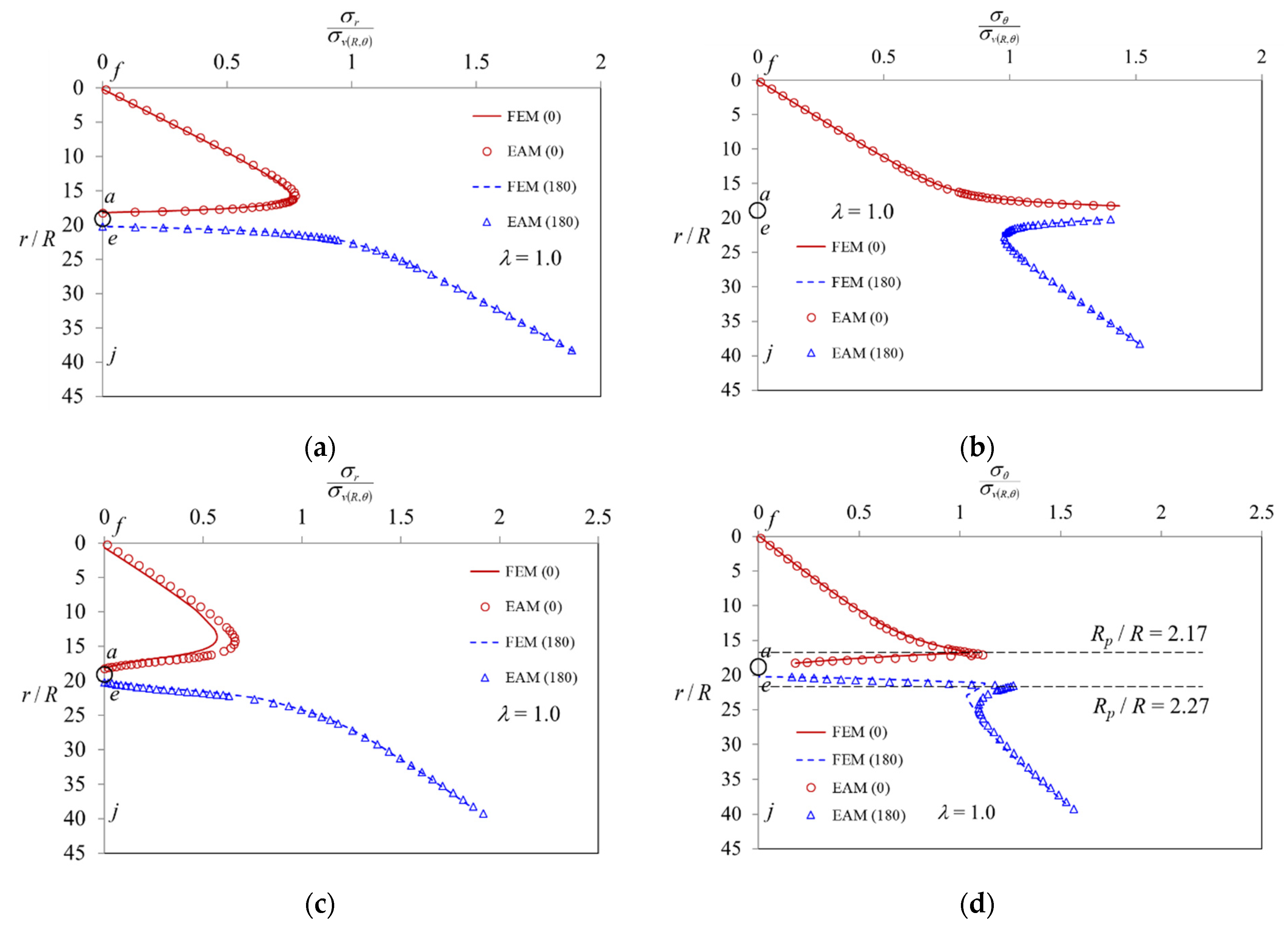
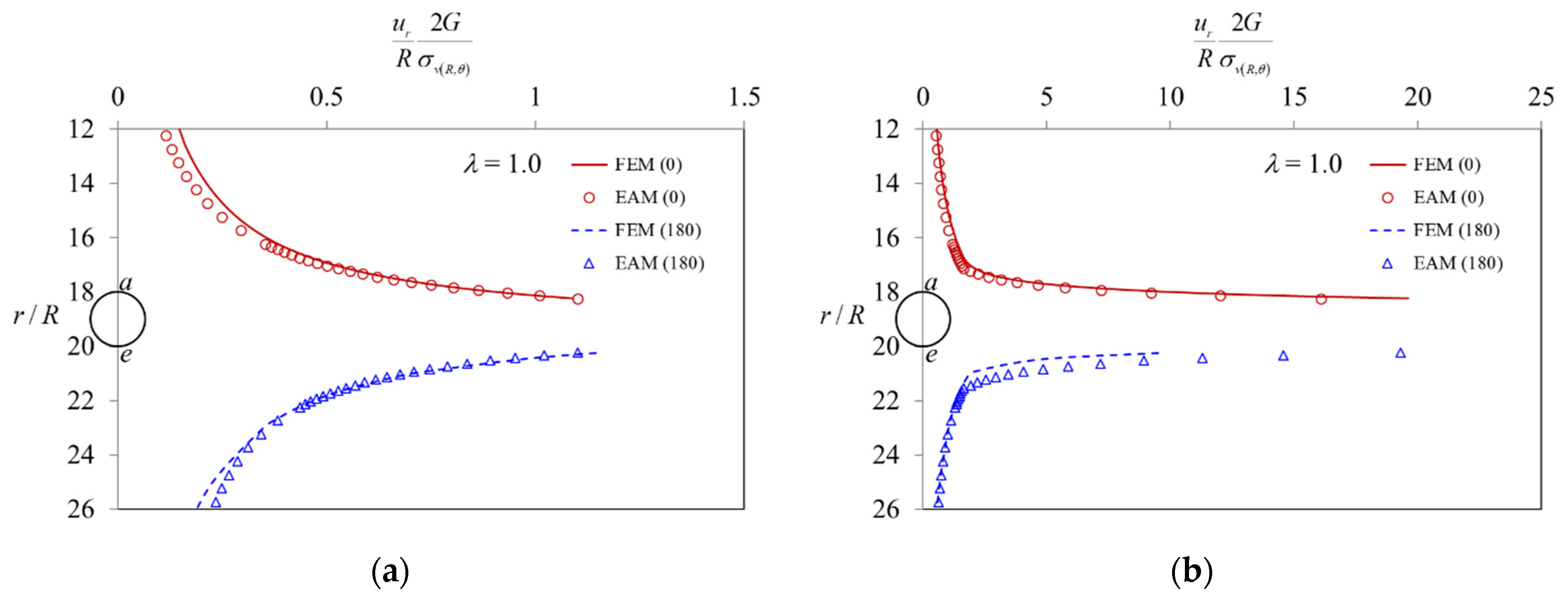
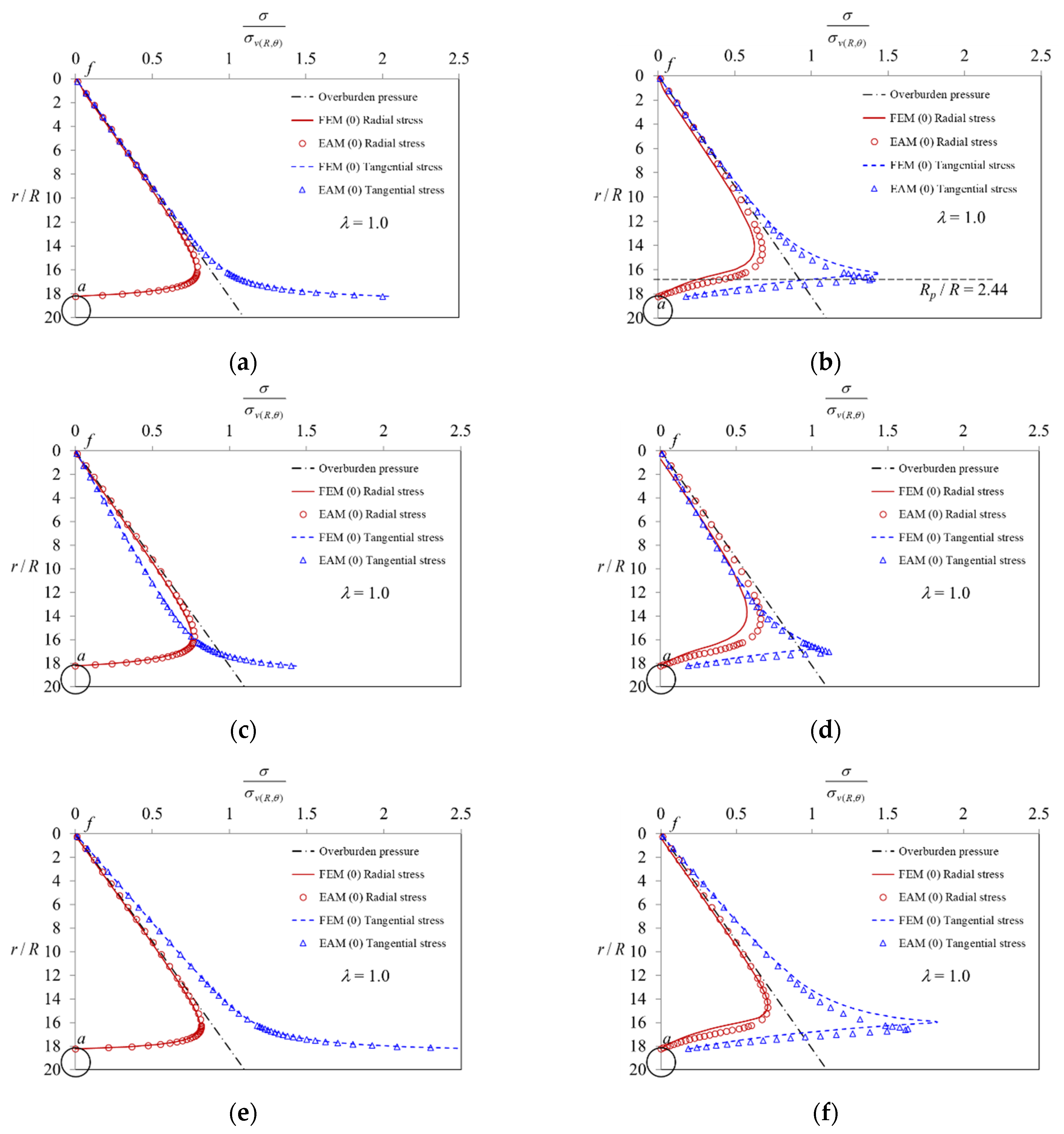
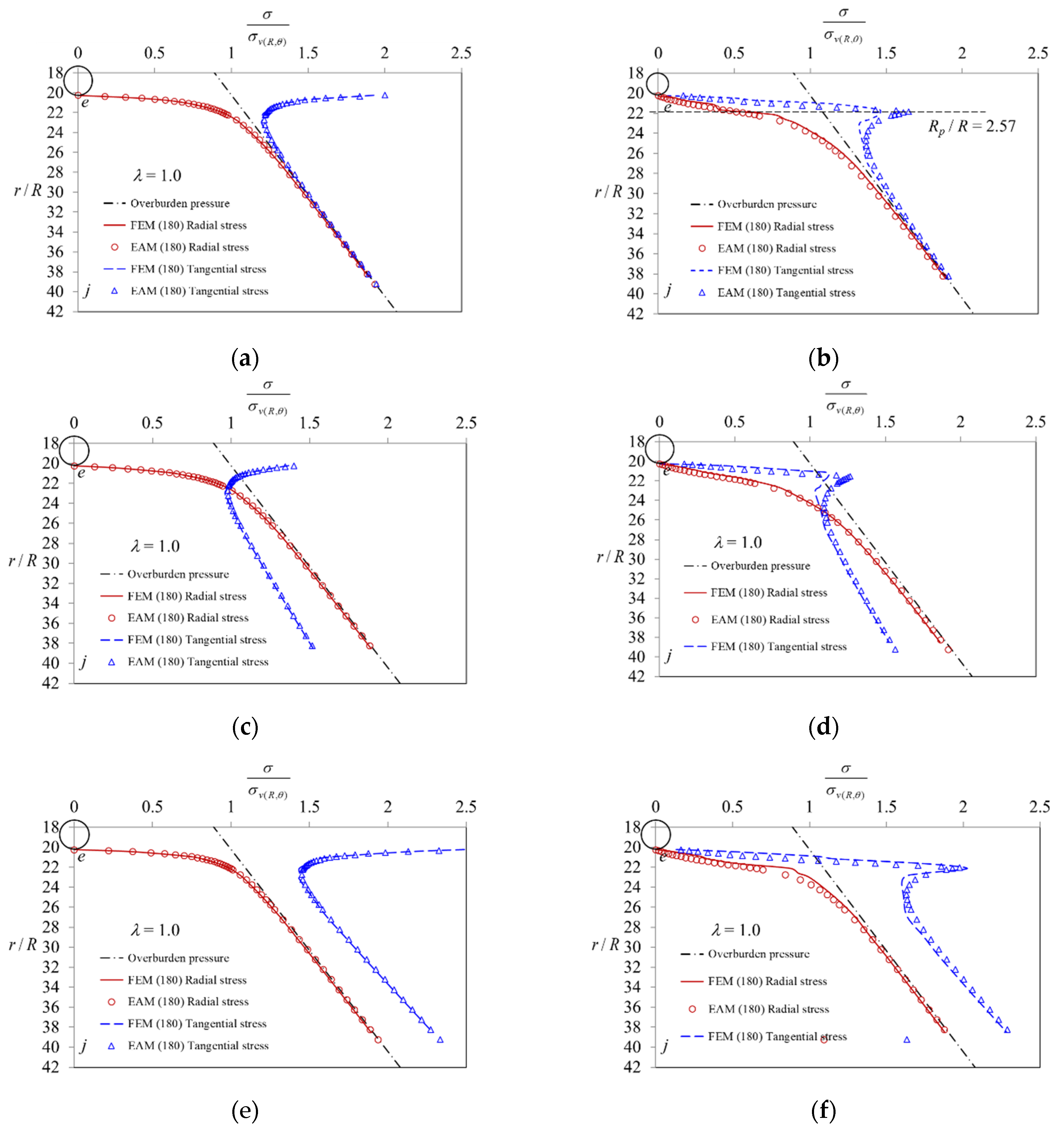
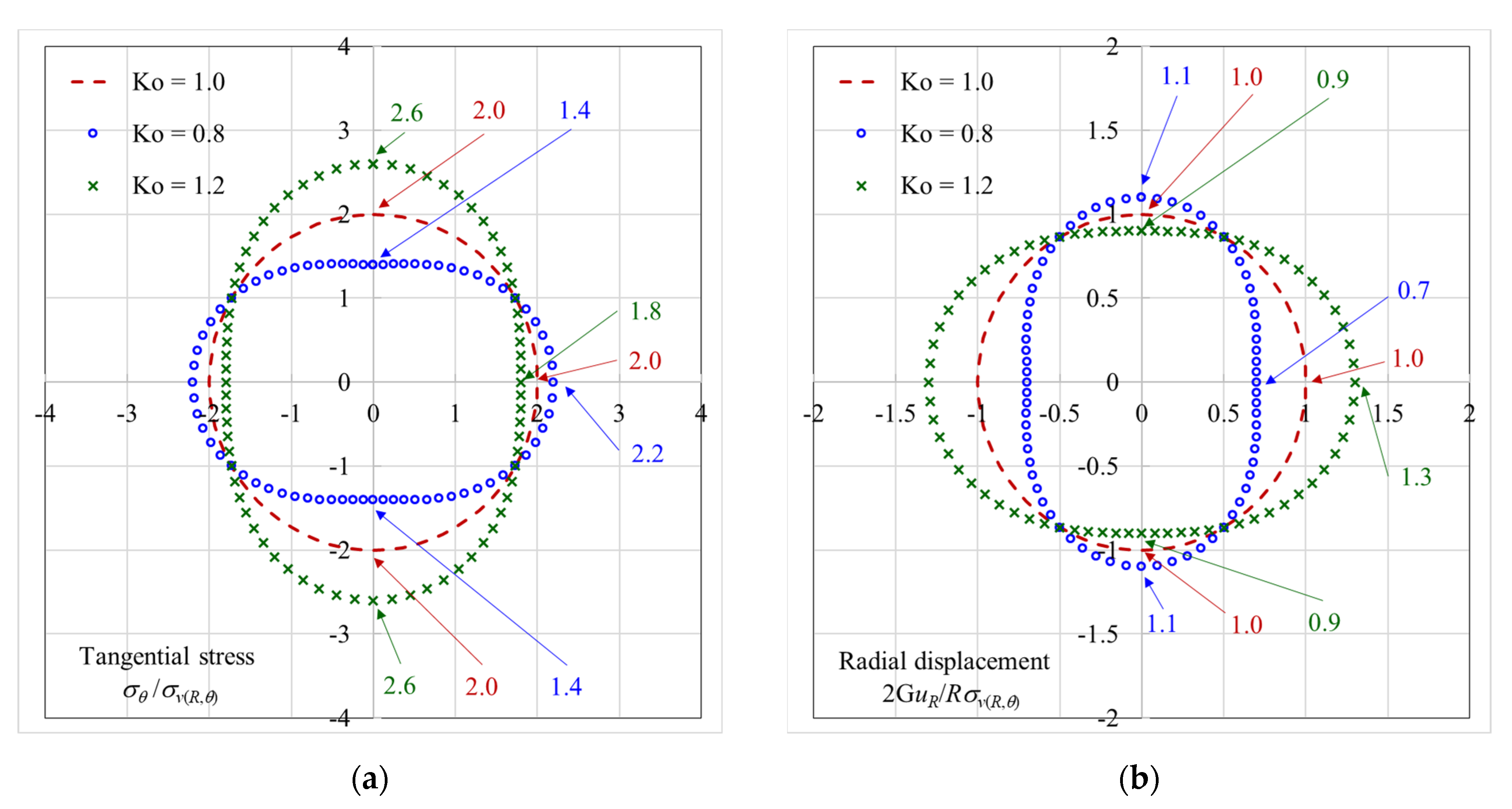
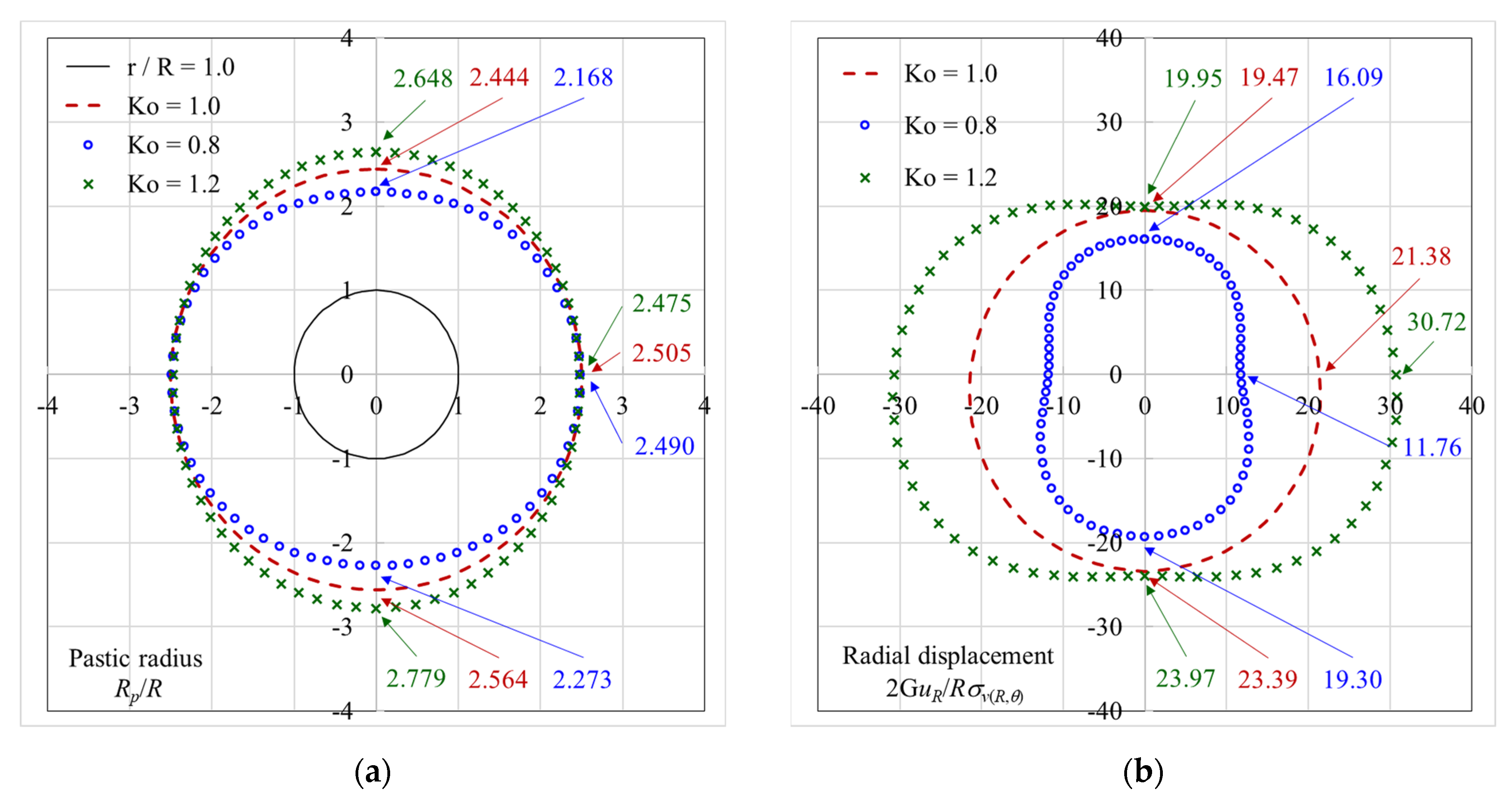
| Parameter | Value |
|---|---|
| Depth of tunnel crown, h (m) | 94.8 |
| In situ stress ratio, Ko | 0.8, 1.0, 1.2 |
| Unit weight, γ (MPa/m) | 0.027 |
| Tunnel excavation radius, R (m) | 5.2 |
| Poisson’s ratio, ν | 0.25 |
| Elastic modulus, E (MPa) | 3000.0 |
| Internal friction angle, φ (°) | 30.0 |
| Cohesion, c (MPa) | 0.1 |
| Dilation angle, ψ (°) | 30.0 |
Disclaimer/Publisher’s Note: The statements, opinions and data contained in all publications are solely those of the individual author(s) and contributor(s) and not of MDPI and/or the editor(s). MDPI and/or the editor(s) disclaim responsibility for any injury to people or property resulting from any ideas, methods, instructions or products referred to in the content. |
© 2023 by the authors. Licensee MDPI, Basel, Switzerland. This article is an open access article distributed under the terms and conditions of the Creative Commons Attribution (CC BY) license (https://creativecommons.org/licenses/by/4.0/).
Share and Cite
Lee, Y.-L.; Zhu, M.-L.; Ma, C.-H.; Chen, C.-S.; Lee, C.-M. Effect of Overburden Depth and Stress Anisotropy on a Ground Reaction Caused by Advancing Excavation of a Circular Tunnel. Mathematics 2023, 11, 243. https://doi.org/10.3390/math11010243
Lee Y-L, Zhu M-L, Ma C-H, Chen C-S, Lee C-M. Effect of Overburden Depth and Stress Anisotropy on a Ground Reaction Caused by Advancing Excavation of a Circular Tunnel. Mathematics. 2023; 11(1):243. https://doi.org/10.3390/math11010243
Chicago/Turabian StyleLee, Yu-Lin, Ming-Long Zhu, Chi-Huang Ma, Chih-Sheng Chen, and Chi-Min Lee. 2023. "Effect of Overburden Depth and Stress Anisotropy on a Ground Reaction Caused by Advancing Excavation of a Circular Tunnel" Mathematics 11, no. 1: 243. https://doi.org/10.3390/math11010243
APA StyleLee, Y.-L., Zhu, M.-L., Ma, C.-H., Chen, C.-S., & Lee, C.-M. (2023). Effect of Overburden Depth and Stress Anisotropy on a Ground Reaction Caused by Advancing Excavation of a Circular Tunnel. Mathematics, 11(1), 243. https://doi.org/10.3390/math11010243







